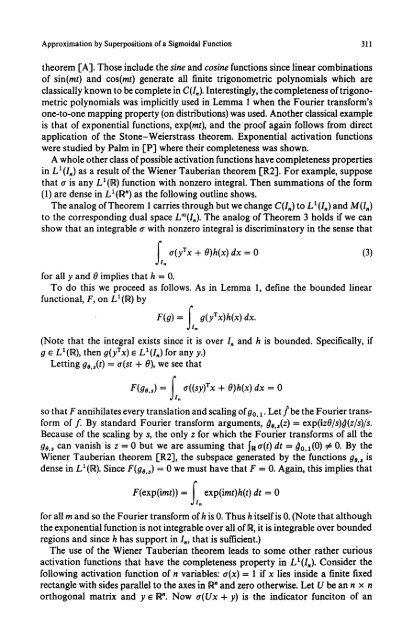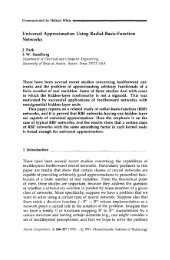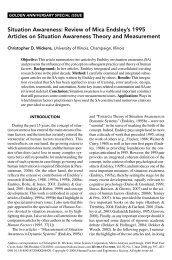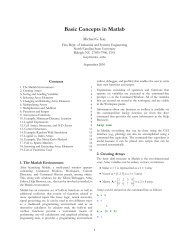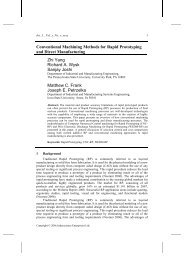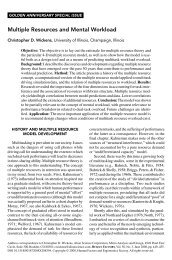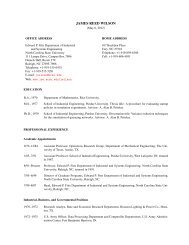Approximation by superpositions of a sigmoidal function
Approximation by superpositions of a sigmoidal function
Approximation by superpositions of a sigmoidal function
Create successful ePaper yourself
Turn your PDF publications into a flip-book with our unique Google optimized e-Paper software.
<strong>Approximation</strong> <strong>by</strong> Superpositions <strong>of</strong> a Sigmoidal Function 311<br />
theorem I-A]. Those include the sine and cosine <strong>function</strong>s since linear combinations<br />
<strong>of</strong> sin(mr) and cos(mt) generate all finite trigonometric polynomials which are<br />
classically known to be complete in C(I.). Interestingly, the completeness <strong>of</strong> trigonometric<br />
polynomials was implicitly used in Lemma 1 when the Fourier transform's<br />
one-to-one mapping property (on distributions) was used. Another classical example<br />
is that <strong>of</strong> exponential <strong>function</strong>s, exp(mt), and the pro<strong>of</strong> again follows from direct<br />
application <strong>of</strong> the Stone-Weierstrass theorem. Exponential activation <strong>function</strong>s<br />
were studied <strong>by</strong> Palm in [P] where their completeness was shown.<br />
A whole other class <strong>of</strong> possible activation <strong>function</strong>s have completeness properties<br />
in LI(I.) as a result <strong>of</strong> the Wiener Tauberian theorem [R2]. For example, suppose<br />
that a is any L I(R) <strong>function</strong> with nonzero integral. Then summations <strong>of</strong> the form<br />
(1) are dense in Lt(R *) as the following outline shows.<br />
The analog <strong>of</strong> Theorem 1 carries through but we change C(I.) to LI(I.) and M(I.)<br />
to the corresponding dual space L~~ The analog <strong>of</strong> Theorem 3 holds if we can<br />
show that an integrable tr with nonzero integral is discriminatory in the sense that<br />
fla(yrx + O)h(x) dx = 0<br />
(3)<br />
n<br />
for all y and 0 implies that h = 0.<br />
To do this we proceed as follows. As in Lemma 1, define the bounded linear<br />
<strong>function</strong>al, F, on LI(I~) <strong>by</strong><br />
t~<br />
F(g) = l g(yrx) h(x) dx.<br />
,11 tt<br />
(Note that the integral exists since it is over I. and h is bounded. Specifically, if<br />
g ~ LI(R), then g(yrx) ~ LI(I.) for any y.)<br />
Letting ge,~(t) = a(st + 0), we see that<br />
F(go,s) = f_ a((sy)rx + O)h(x) dx = 0<br />
dl n<br />
so that F annihilates every translation and scaling <strong>of</strong> go, 1. Let f be the Fourier transform<br />
<strong>of</strong> f. By standard Fourier transform arguments, #0,,(z) = exp(izO/s)#(z/s)/s.<br />
Because <strong>of</strong> the scaling <strong>by</strong> s, the only z for which the Fourier transforms <strong>of</strong> all the<br />
go,s can vanish is z = 0 but we are assuming that Saa(t) dt = ~o,1(0) ~ 0. By the<br />
Wiener Tauberian theorem [R2], the subspace generated <strong>by</strong> the <strong>function</strong>s go,, is<br />
dense in Lt(R). Since F(ge.~) = 0 we must have that F = 0. Again, this implies that<br />
F(exp(imt)) = I_ exp(imt)h(t) dt = 0<br />
.11 n<br />
for all m and so the Fourier transform <strong>of</strong>h is 0. Thus h itself is 0. (Note that although<br />
the exponential <strong>function</strong> is not integrable over all <strong>of</strong> R, it is integrable over bounded<br />
regions and since h has support in I., that is sufficient.)<br />
The use <strong>of</strong> the Wiener Tauberian theorem leads to some other rather curious<br />
activation <strong>function</strong>s that have the completeness property in LI(I.). Consider the<br />
following activation <strong>function</strong> <strong>of</strong> n variables: tr(x) = 1 if x lies inside a finite fixed<br />
rectangle with sides parallel to the axes in R n and zero otherwise. Let U be an n x n<br />
orthogonal matrix and y E R n. Now a(Ux + y) is the indicator funciton <strong>of</strong> an


